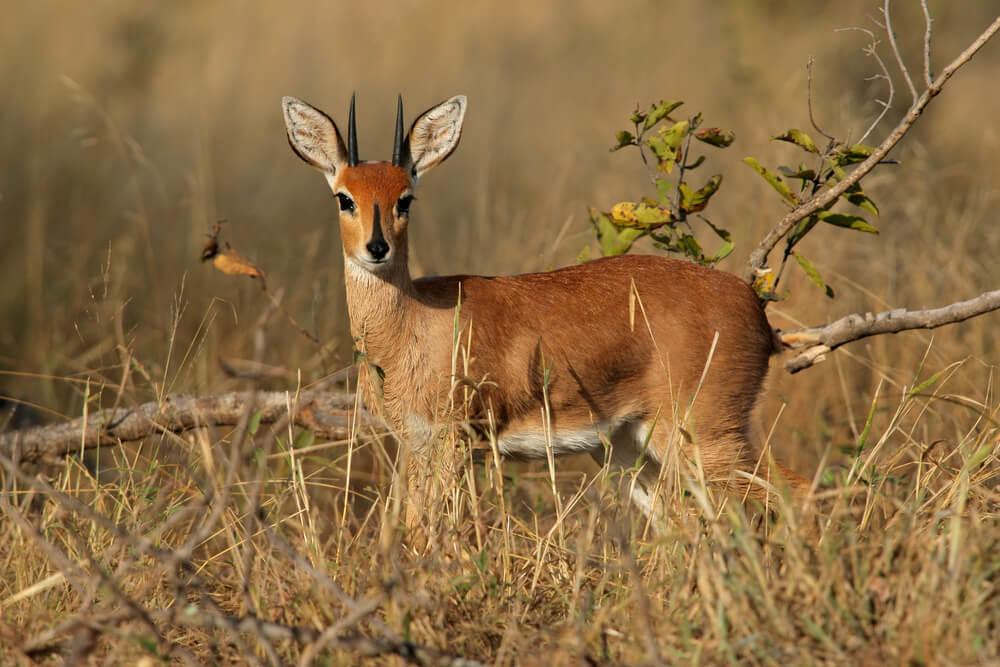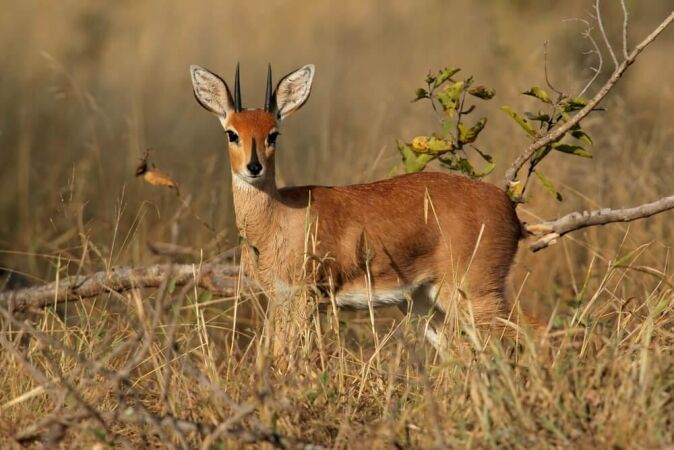

The steenbok (Raphicerus campestris) is a common small antelope, a member of Africa’s Tiny 10 and is found in eastern and southern Africa. Africa plains game are sought-after animals to hunt in Africa and the steenbok is no exception. Steenboks provide a hunter with a plenty of variations in vegetation when on a hunting safari as they prefer a variety of habitats including semi-desert, open woodlands and thickets, including open plains, savannas and grasslands. IUCN Red List classifies Steenbok as “least concern.”
Steenboks are active early in the day when it is still cool and then again later in the afternoon as the heat subsides. A steenbok is herbivorous and its diet includes leaves, berries, seeds, and grasses. They are mainly browsers but will use their front hooves to dig for roots and bulbs.
They are solitary animals who only come together to mate. The gestation period is roughly 177 days and the female will give birth to one offspring. Steenbok mate at any time during the year that the female is on heat, but there is a peak in births at the start of the rainy season.
Steenboks are territorial and males will mark their territories with urine and secretions from a gland under their chin as well as using dung. Being so tiny, the steenbok has a great many predators. They are hunted by all members of the cat family, jackals, caracals, large birds of prey and snakes.
The little steenbok has excellent eyesight and hearing and is always on alert to ward off any danger. At the first sign of trouble, it will lie low and hide in the vegetation. Should the predator or threat get too close for comfort, they will leap out and run away, using the typical zig-zag pattern to try and evade capture. Their only mistake is stopping at times to look back and see how far away the danger is, and if it is still prevalent. This behavior can certainly cost them dearly!
To assist in their escape plans, they also commandeer other animal’s burrows or holes. An example of this is the aardvark’s burrow in which they hide.
Name:
Raphicerus Campestris
Weight:
24 pounds
Shoulder Height:
15-24 inches
Range:
Eastern and Southern Africa
Mating Season:
Not specific
Horns:
Male only
Breeding:
Year-round with a peak at the beginning of the rainy season
Life span:
11 years
The Steenbok is a Member of Africa’s Tiny 10.
When game hunting in Africa and searching for steenbok, look for a small antelope with an orangey colored coat. Their underbelly is white as well as their chin and throat area. Their little tail is not usually visible as it is only 1.5-2.3 in long. There is a black crescent shape located between the ears and a long black bridge to the glossy black nose. There is also a black circular scent gland under each eye. Only the males of the species have horns that are straight, smooth and parallel horns, measuring roughly 3-7.5 inches in length.
Steenboks can be harvested in the following African countries while on a game hunting safari: South Africa, Namibia, Botswana, Zimbabwe and Tanzania. IUCN Red List classifies Steenbok as “least concern.” Unless you are specifically targeting steenbok, they will come as an opportunistic hunt while targeting other Africa plains game on your hunting safari.
The steenbok remains a trophy of opportunity but still one worth capturing as a member of Africa’s Tiny 10. The challenge in hunting this minute antelope is actually finding it in the vegetation after it camouflages itself in the vegetation.
Steenbok hides are easily damaged by high powered rifles. Steenbok are small and dainty African antelope. When steenbok hunting, use a low powered rifle like a .22 (if legally allowed) or a .270. The bullet tips need to be solids. These smaller calibers offer a good balance of trajectory and precision.
Search from our range of Hunts across various popular destinations in Africa.
Find A Hunt